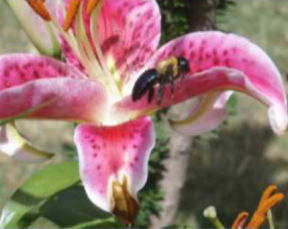By GSWA Volunteer, Jim Northrop
As beekeepers are waking up their bees to go to work, they are finding more of them have died off. Why? Scientists are concluding that, as the bees help produce our food by pollinating flowers and buds of various kinds, they encounter toxic compounds in the plants on which they feed.
These toxic compounds or pesticides are known as “neonicotinolds.” They were designed to antagonize the nerve receptors of invertebrates, but not interfere with similar receptors in vertebrate animals. So, neonicotinoid pesticides have been declared safe for fish, mammals, birds, reptiles and humans —- but not for bees!
Honeybees make up the bulk of bees used to pollinate commercial crops. But, because honey is “lipophobic” (i.e., water and oil that do not mix) the honey of the bee rarely ever picks up detectable levels of pesticides and remains safe. However, bees do retain the pesticide —- and they die.
Researchers have found that bees are unable to taste the neonicotinoid compound, but that bees apparently prefer to consume it anyway because of how the nicotine-like substance affects their brains.
Neonicotinold pesticides are often found in small spray bottles, such as Bayer Advanced Rose and Flower Insect Killer, and Ortho Bug-B-Gone. Such pesticides are inexpensive and even packaged for convenient use in one’s home or garden. These neonicotinoids are said to be 6,000 times more toxic than DDT.
In the United States most corn and many soybean crops are grown from seeds impregnated with neonicotinoids, so that the pesticide is contained within the plant instead of being merely sprayed on. Insects that suck or chew on the plant are poisoned when they feed, but the compound typically breaks down before harvest.
In 2013, the European Union voted to suspend the use of three common neonicotinoids on crops that attract bees, until more studies could be completed. In the U. S., The Environmental Protection Agency is conducting a lengthy review of bee-killing neonicotinoid pesticides. But had the agency gone far enough? Then, in April, 2015, the EPA announced a moratorium on approving any new bee-killing neonicotinoid pesticides. These studies are still underway, leaving unanswered the question of how to balance the impact of pesticides on ordinary honeybees.
There is a second threat to honeybees, and scientists consider it to be a major contributor to the upswing in bee deaths. Co-existing with the honeybees, there is a tiny Varroa mite, small enough to be a bee parasite. This appears to be a greater problem for so-called “backyard” beekeepers, who keep fewer than 50 hives, than among commercial beekeepers.
Varroa destructor (the Varroa mite) is an external parasite mite that attacks the honey bees Apis cerana and Apis mellifera. This mite, which looks somewhat like a tick, is about the size of a pinhead, and is visible to the naked eye.
The Varroa mite can only reproduce in a honeybee colony or beehive. The mite attaches to the thorax or abdomen of the bee and weakens the bee by sucking hemolymph (“blood”) for sustenance. By leaving open wounds on the bee, the mite facilitates the entry of diseases and viruses which easily infect the bee. A common such a virus is one that deforms the bee’s wings so that the bee cannot take care of itself. Varroa mites also reproduce in the embryonic brood cells of the honeybees. A Varroa population can double every three to four weeks.
A significant mite infestation will lead to the death of the entire honey bee colony. The Varroa mite may be the largest factor contributing to bee colony collapse disorder. Apis mellifera bees have been said to be almost completely defenseless against these parasites.
Biologists believe that the Varroa mite originally came from Asia and was introduced through Florida in the 1980’s, but the mite is now found throughout the United States and Canada. Increasingly, Varroa mites are being treated successfully with commercially available miticides, but the process requires diligence on the part of the beekeeper.
Pollination —- the transfer of pollen from one flower to another, typically by wind, bug or bird, is essential to the global food supply. An estimated 75% of all traded crops, including apples, soybeans and corn, depend on pollination. What happens if the bees disappear? It’s quite simple —- no bees, no food.
- Please note that there is new scientific evidence suggesting that neonicotinoids may not be as harmful to bees as previously believed. You can read more here.


